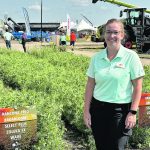Tag Archives aphanomyces

Managing diseases in alfalfa
From seedling issues to stand die-off, understanding the timing and symptoms of alfalfa diseases can help protect yield

Tank mix boosts aphanomyces seed treatment
Adding UPL’s Belmont as a tank mix to Rancona Trio increases the product’s effectiveness from suppression to control
Glacier FarmMedia – Farmers have another weapon in their arsenal to combat aphanomyces root rot. It’s been two years since UPL’s Rancona Trio was registered for early season suppression of aphanomyces in lentils and peas, but its product Belmont is now registered as a tank mix option for the Rancona Trio. It provides early season […] Read more
Website launched to fight pulse root rot

Root rot in research lens

Aphanomyces soil test gets refined

Make the most of a pause from pulses
Growers forced by disease to eschew peas and lentils have options to stay productive while the threat abates
It’s a bitter pill to swallow, but pulse producers across the Prairies have come to expect it. If there is aphanomyces root rot in a field where peas, lentils or other susceptible pulses are grown, there is little choice but to rotate crops without those pulses until the disease is gone. That can take six […] Read more
Disease management comes down to basics
With resistance still an elusive research goal, rotation of both crops and fungicides remains the best tool against disease
Identifying and managing diseases is crucial to yield and grain quality. Spraying technology, chemical application and new seed varieties help in the battle for healthy crops, but fungi, bacteria and other microorganisms continuously adapt, becoming resistant to genetic defences and crop protection products. So, what are the latest threats? Green and yellow peas, chickpeas, lentils, […] Read more
New research strategy developed for root rot
Sask. gov’t, farm groups kick in $4.2 million to tackle aphanomyces and other diseases that threaten pea and lentil crops
A $4.2 million investment in root rot research is a “big deal” for farmers and Canada’s pulse industry, says a University of Saskatchewan scientist. Saskatchewan agriculture minister David Marit announced $2.5 million in provincial and federal funding last week to find solutions for root rot in peas and lentils. Saskatchewan Pulse Growers, the Western Grains […] Read more
Seeking sources of pea root rot resistance
Pea breeders are heading back to U.S. and French roots in search of genes for durable resistance against aphanomyces
Greenhouse testing at the University of Saskatchewan has shown that several pea varieties have partial resistance. But those results come with a large asterisk: indoor conditions are very different from field conditions.
Pulse breeders get serious about tackling root rot problem
A joint Limagrain-Saskatchewan Pulse Growers program is in full swing as it searches for a solution to aphanomyces
In the latest episode of Saskatchewan Pulse Growers' Pulse of the Prairies podcast, Jason Reinheimer of Limagrain said the French company is combining the best-known sources of resistance from North America and Europe to combat the devastating root rot disease.




